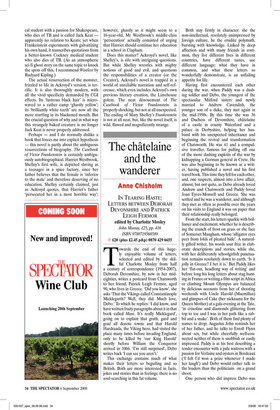Rekindling life in a dead frame
Caroline Moore
THE CASEBOOK OF VICTOR FRANKENSTEIN by Peter Ackroyd Chatoo and Windus, £16.99, pp. 296 ISBN 9780701182953 ✆ £13.59 (plus £2.45 p&p) 0870 429 6655 Why re-write Frankenstein or The Modern Prometheus as The Casebook of Victor Frankenstein? The rewriting of well-known novels generally depends upon two techniques. The first involves recasting the narrator: telling the tale from a different point of view, usually that of the historical underdog (women, servants, woodworm, etc). The second is to update the novel, reinventing it in modern dress.
Peter Ackroyd’s narrator, however, is exactly the same as Mary Shelley’s (give or take the now forgot framing device): Victor Frankenstein’s narration is interspersed, just as in the original, with long interludes from a monster endowed with preternatural Romantic magniloquence, though Ackroyd’s monster learned his English from Robinson Crusoe rather than Paradise Lost. And as for updating: Ackroyd’s novel is embedded even more specifically in the 19th-century than the Romantic original ever was.
Indeed, the central conceit of The Casebook of Victor Frankenstein is that Victor Frankenstein leaves Ingoldstadt to study at Oxford University, where he becomes friends with the atheist poet, Shelley. He also meets Byron, Godwin, Polidori (Byron’s doctor, but also author of the first vampire story published in English), and both Shelley’s wives — Harriet Westbrook and Mary Godwin, the daughter of the author of A Vindication of the Rights of Women and the author of the original Frankenstein.
Ackroyd’s novel is, like its famous predecessor, immensely readable. It crackles with that peculiar mixture of ebullience and self-loathing that galvanises Ackroyd’s resurrection of the past. His ear for Romantic language is almost pitch-perfect, without ever becoming slavish (actually, it is Mary Shelley’s characters who talk like animated warming-pans — but one must remember that she, remarkably, was only 19 when she wrote her extraordinary novel).
Yet Ackroyd’s fiction is destined or indeed designed never to achieve fully independ ent life. It is by its nature a hybrid, a patchwork, a parasite. For its effect, it depends upon the reader noticing the seams.
Simpler adaptations with simpler motives are easier to read. One can watch Boris Karloff in surely the best Frankenstein film without ever wondering why Victorthe-scientist swaps first names with Henrythe-best-friend. And the introduction of hunchbacked Fritz, and the whole braindropping and brain-swapping incident, arehistorically fascinating: in 1931, the audience evidently needed an explanation for the evil of the monster more hard-wired than Mary Shelley’s haunting liberal notion that the monster is malignant because he is ‘miserable’. Yet the film itself stands alone: it can be seen, as can that enchanting Spanish film, The Spirit of the Beehive, through the fascinated eyes of a child.
The Casebook of Victor Frankenstein is altogether more knowing. One is, surely, meant to notice departures from the original novel The most obvious departure is in the physical creation of the monster. Mary Shelley’s ‘fiend’ is possibly but not certainly created from bit parts. Her Frankenstein certainly scrabbles around filthy ‘charnel-houses’, but it is never clear whether he is merely researching ‘the tremendous secrets of the human frame’, or actively recycling. Why, after all, should a composite made up of normal-sized parts end up eight foot tall? Shelley’s original Frankenstein tells us that he made his monster large to overcome technical, pre-micro-chip problems, ‘as the minuteness of the parts formed a great hindrance to my speed’.
This only emphasizes that Mary Shelley’s monster is, above all, completely created rather than merely re-animated. The actual details of its construction and vivification are left cloudy (there is no mention even of galvanic electricity, let alone a brain, in Shelley’s account – only unspecified chemical apparatus).
Ackryod’s monster is utterly different. His is a single, re-animated corpse. Very specifically, it is the corpse of a Cockney medi cal student with a passion for Shakespeare, who dies of TB and is called Jack Keat — apparently no relation to Keats; yet when Frankenstein experiments with galvanizing his own hand, it transcribes quotations from a better-known Cockney medical student who also dies of TB. (As an atmospheric sci-fi ghost story on the same topic to knock the spots off this, I recommend Wireless by Rudyard Kipling.) The actual resurrection of the monster, frizzled to life in Ackroyd’s version, is terrific. It is also thoroughly modern, with all the vivid specificity demanded by CGI effects. Its ‘lustrous black hair’ is microwaved to a rather camp ‘ghastly yellow’; its ‘brilliantly white teeth’ are now all the more startling in its blackened mouth. But the crucial question of why and in what way this strangely baked creature is no longer Jack Keat is never properly addressed.
Perhaps — and I do normally dislike a book that forces me into explicit hypothesis — this novel is partly about the ambiguous resurrections of biography. The Casebook of Victor Frankenstein is certainly ambiguously autobiographical. Harriet Westbrook, Shelley’s first wife, is depicted slaving as a teenager in a spice factory, since her father believes that the female is ‘inferior to the male’ and therefore deserving of no education. Shelley certainly claimed, just as Ackroyd quotes, that Harriet’s father ‘persecuted her in a most horrible way’; however, ghastly as it might seem to a 16-year-old, Mr Westbrook’s middle-class ‘persecution’ actually consisted of urging that Harriet should continue her education in a school in Clapham.
Does this matter? Ackroyd’s novel, like Shelley’s, is rife with intriguing questions. But while Shelley wrestles with mighty notions of good and evil, and questions the responsibilities of a creator (or the Creator), Ackroyd’s novel is trapped in a world of unreliable narration and self-reference, which even includes Ackroyd’s own previous literary creation, the Limehouse golem. The neat dénouement of The Casebook of Victor Frankenstein is properly shocking, but not at all unexpected. The ending of Mary Shelley’s Frankenstein is not at all neat, but, like the novel itself, is wild, flawed and magnificently strange.



































































 Previous page
Previous page